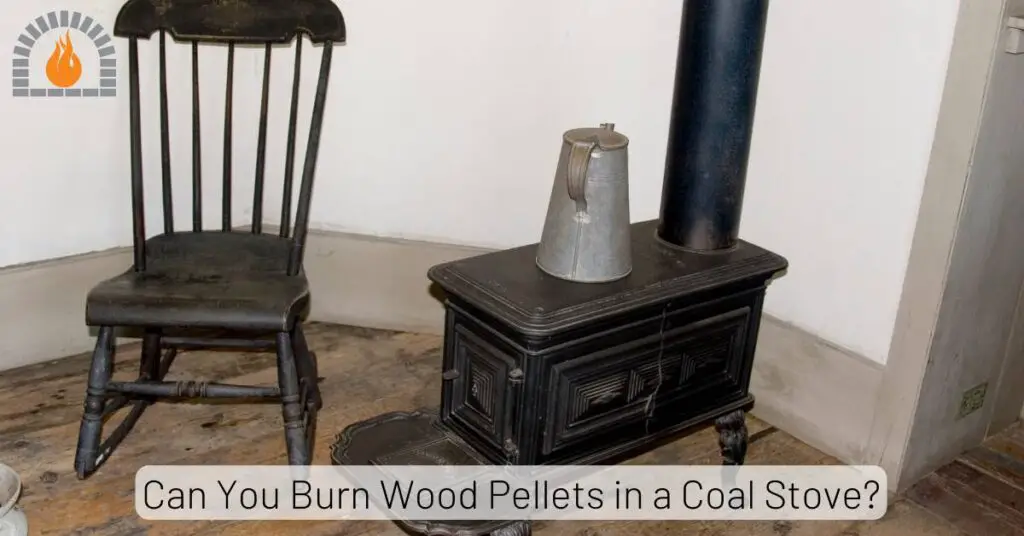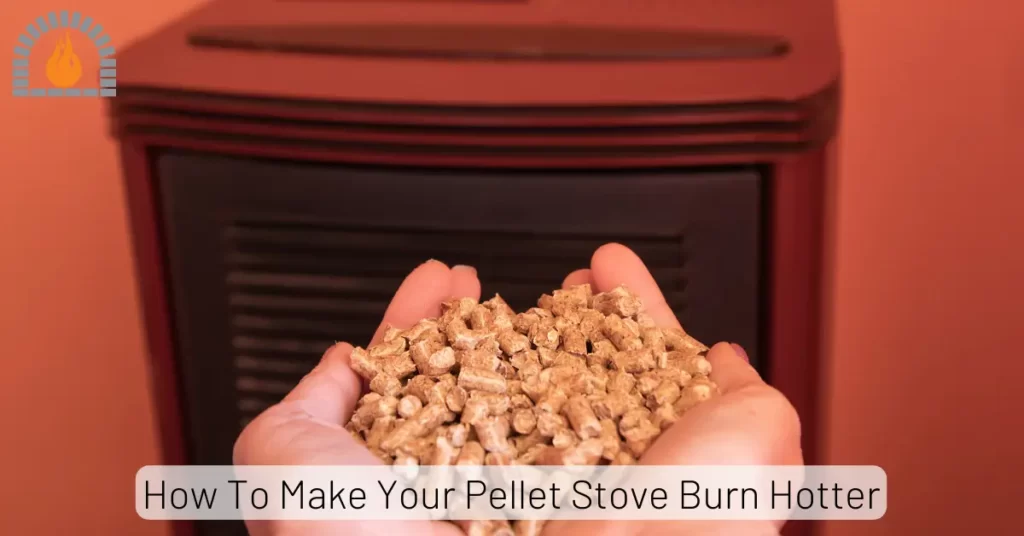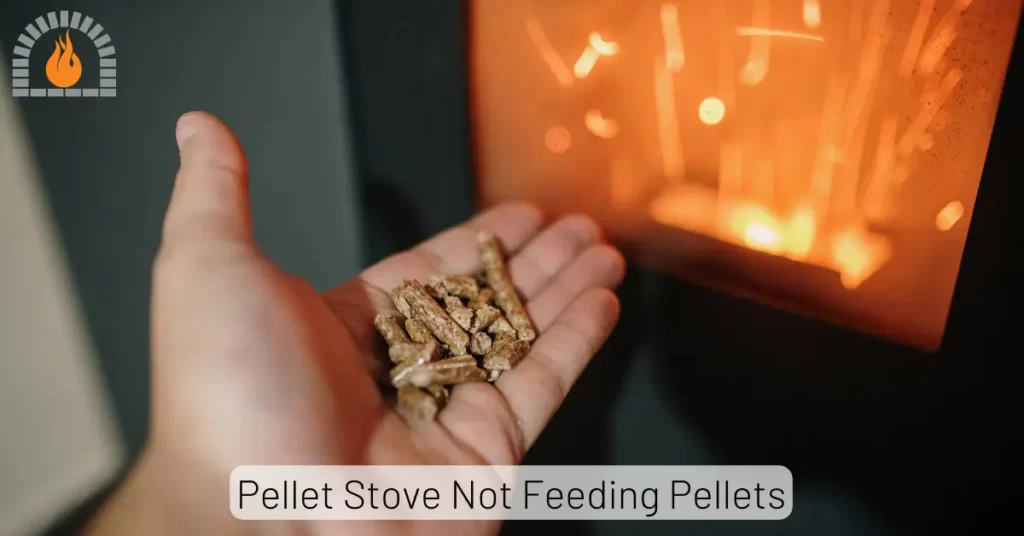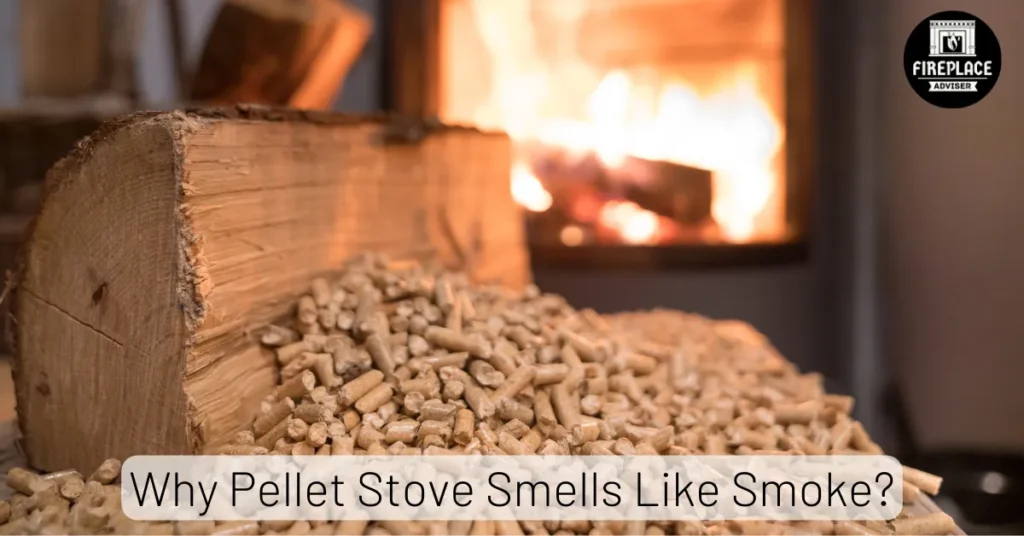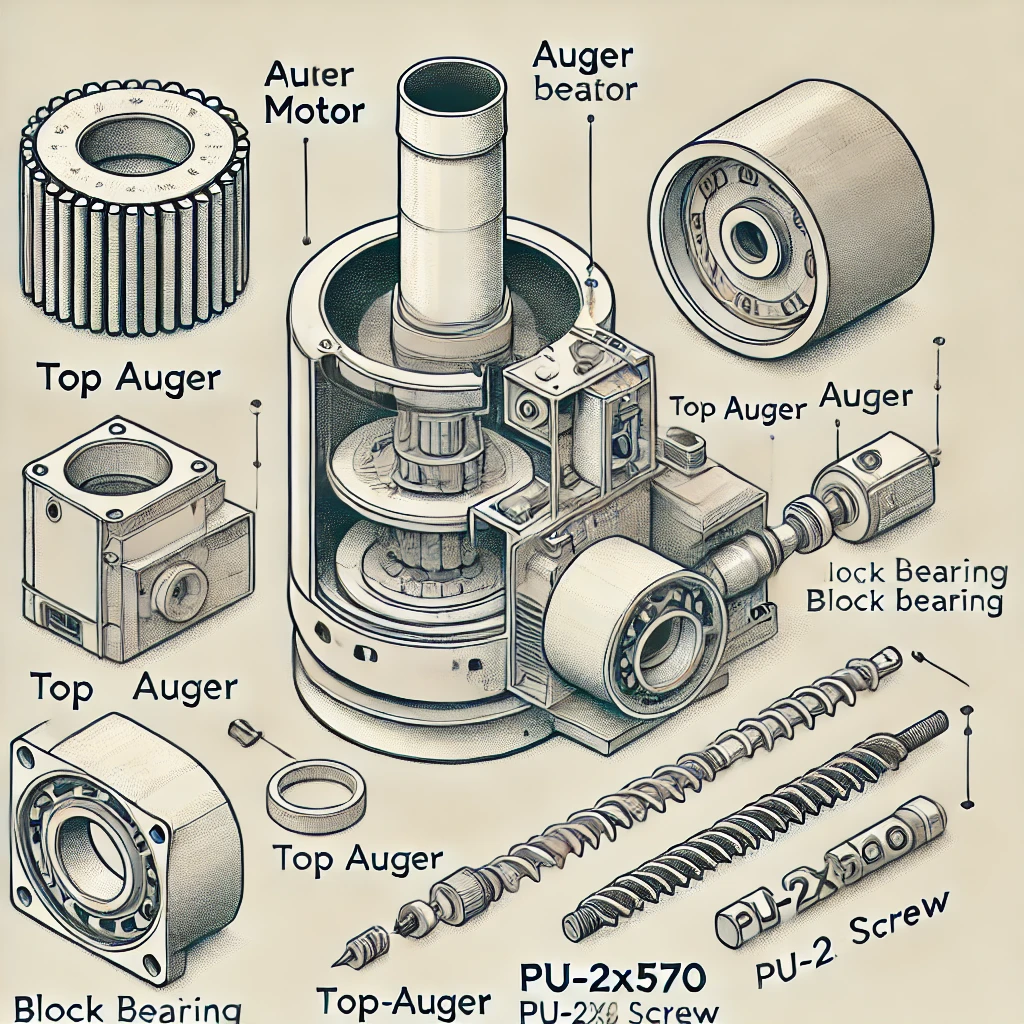When choosing between hardwood vs softwood pellets for your heating needs, you’re deciding between two distinct fuel sources with unique characteristics. Hardwood pellets, typically made from dense woods like oak and maple, generally offer higher BTU content per pound but often at a higher price point. Softwood pellets, derived from coniferous trees like pine firewood and fir firewood, tend to burn cleaner with less ash residue and may provide better ignition properties.
The right choice depends on your specific heating appliance, budget, and preferences regarding heat output, maintenance, and environmental impact.
This comprehensive guide will help you understand the critical differences between these two popular biomass fuel options so you can make an informed decision for your home heating needs.
Key Takeaways
- Heat Output: Hardwood pellets generally provide higher BTU content per pound (8,000-8,500 BTU/lb) compared to softwood pellets (7,500-8,200 BTU/lb), but softwood pellets often burn hotter and faster due to resin content.
- Cost Efficiency: Softwood pellets are typically 10-15% less expensive than hardwood pellets, potentially offsetting the BTU difference for budget-conscious consumers.
- Ash Production: Softwood pellets produce significantly less ash (0.3-0.6%) compared to hardwood pellets (0.6-1.2%), meaning less frequent cleaning of your stove.
- Environmental Impact: Both types are carbon-neutral when sourced sustainably, but softwood pellets often have a slight edge as they utilize faster-growing trees and sometimes waste materials from lumber production.
- Storage Considerations: Both require dry, protected storage, but softwood pellets may be slightly more resistant to moisture absorption due to higher resin content.
Hardwood vs Softwood Pellets
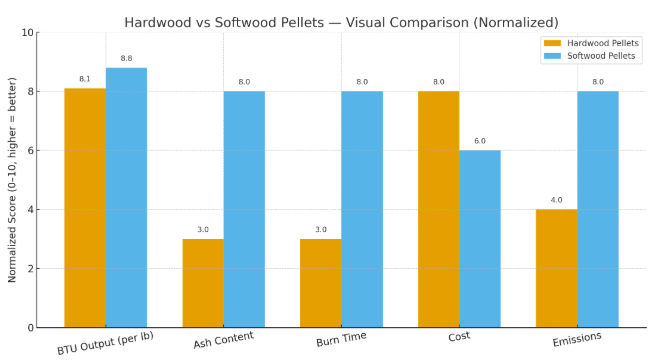
Hardwood Pellets: Characteristics and Benefits
Hardwood pellets are manufactured from deciduous trees such as oak, maple, birch, and hickory. These trees are known for their dense wood structure, which translates into specific characteristics when processed into pellets:
Physical Properties
- Density: Higher density due to the nature of hardwood fibers
- Color: Typically darker, ranging from tan to deep brown
- Size: Standard 6-8mm diameter with 10-30mm length
- Moisture Content: Usually 6-8% when properly manufactured
Performance Characteristics
- BTU Output: Generally 8,000-8,500 BTU per pound
- Burn Rate: Slower, more sustained burn
- Ash Production: Higher, typically 0.6-1.2% by weight
- Flame Characteristics: Steady, consistent flame with moderate height
Benefits of Hardwood Pellets
- Longer Burn Time: The dense nature of hardwood pellets means they burn more slowly, potentially extending time between refills in some stove models.
- Higher Energy Density: More heat potential per unit of volume due to the dense fiber structure.
- Wide Availability: Hardwood pellets are widely available across North America, especially in eastern regions where hardwood forests are prevalent.
- Less Resin: Lower resin content means less potential for creosote buildup in chimneys and venting systems.
Softwood Pellets: Characteristics and Benefits
Softwood pellets are produced from coniferous trees such as pine, fir, spruce, and cedar. These trees have different wood characteristics that result in distinct pellet properties:
Physical Properties
- Density: Lower density compared to hardwood pellets
- Color: Generally lighter, ranging from pale yellow to light brown
- Size: Standard 6-8mm diameter with 10-30mm length
- Moisture Content: Typically 5-7% when properly manufactured
Performance Characteristics
- BTU Output: Generally 7,500-8,200 BTU per pound
- Burn Rate: Faster, more intense burn
- Ash Production: Lower, typically 0.3-0.6% by weight
- Flame Characteristics: Brighter, higher flame with more visible combustion
Benefits of Softwood Pellets
- Lower Ash Content: The most significant advantage is the reduced ash production, meaning less frequent cleaning of your stove and less waste to dispose of.
- Better Ignition: Higher resin content makes softwood pellets easier to ignite and helps them achieve optimal combustion temperature more quickly.
- Cleaner Burn: The lower ash content and higher combustion temperatures often result in cleaner glass on your stove and less buildup in the burn pot.
- Environmental Benefits: Softwood trees grow faster than hardwoods, making them a more rapidly renewable resource in many regions.
Hardwood vs Softwood Pellets BTU Comparison
When comparing hardwood vs softwood pellets, understanding the BTU (British Thermal Unit) output is crucial as it directly relates to heating potential. BTU measures the amount of heat energy required to raise the temperature of one pound of water by one degree Fahrenheit.
The Science Behind BTU Differences
The BTU content of wood pellets is influenced by several factors:
- Wood Density: Hardwood has more fibers per unit volume, contributing to higher BTU content.
- Resin Content: Softwoods contain more resins, which have high energy values and can increase the effective heat output during combustion.
- Moisture Content: Lower moisture content means less energy is wasted evaporating water, resulting in more available heat.
Comparative BTU Analysis
While hardwood pellets typically have higher BTU ratings per pound, the actual heat output in your stove may not directly correlate with these numbers due to combustion efficiency and heat transfer characteristics.
| Property | Hardwood Pellets | Softwood Pellets |
|---|---|---|
| Average BTU per pound | 8,000-8,500 | 7,500-8,200 |
| Resin content | Low | High |
| Combustion temperature | Moderate | Higher |
| Heat transfer efficiency | Good | Excellent |
Cost Comparison: Which Is More Economical?
When evaluating the economics of hardwood pellets versus softwood pellets, several factors beyond the bag price must be considered to determine true cost efficiency.
Upfront Cost Analysis
Generally, softwood pellets cost 10-15% less than hardwood pellets. The price difference can be attributed to:
- Raw Material Availability: Softwood trees grow faster and are more abundant in many regions.
- Production Efficiency: Softwood fibers are often easier to process and require less energy to compress into pellets.
- Market Factors: Regional availability and transportation costs significantly impact pricing.
| Region | Hardwood Pellet Cost | Softwood Pellet Cost | Price Difference |
|---|---|---|---|
| Northeast | $250-$300 | $220-$270 | $30-$50 less |
| Southeast | $230-$280 | $200-$250 | $30-$50 less |
| Midwest | $240-$290 | $210-$260 | $30-$50 less |
| Northwest | $260-$310 | $240-$290 | $20-$40 less |
| Southwest | $270-$320 | $250-$300 | $20-$40 less |
Long-Term Cost Considerations
To determine the true cost efficiency, consider these factors:
- Heating Efficiency: Softwood pellets often burn more completely, extracting more usable heat from each pellet.
- Stove Maintenance: Lower ash content in softwood pellets means less frequent cleaning and potentially lower maintenance costs.
- Storage Losses: Softwood pellets may be slightly more resistant to moisture damage, potentially reducing losses from improper storage.
- Appliance Compatibility: Some stoves are specifically designed to work better with one type of pellet, affecting overall efficiency.
Calculating True Cost per BTU
To determine the most economical option, calculate the cost per million BTUs:Line Wrapping
Cost per million BTUs = (Cost per ton ÷ BTUs per pound × 2,000) × 1,000,000
For example:
- Hardwood pellets at $280/ton with 8,200 BTU/lb: $17.07 per million BTUs
- Softwood pellets at $250/ton with 7,800 BTU/lb: $16.03 per million BTUs
In this scenario, despite the lower BTU content, softwood pellets provide more economical heating.
Efficiency Analysis
The efficiency of wood pellet fuel depends significantly on the type of heating appliance used. Different stoves are engineered with specific combustion characteristics that may perform better with one type of pellet over the other.
Pellet Stove Types and Their Preferences
- Bottom-Fed Stoves
- Work well with hardwood pellets due to their slower burn rate
- May struggle with very low-ash softwood pellets that burn too quickly
- Benefit from the consistent, slow-burning nature of hardwood pellets
- Top-Fed Stoves
- Generally perform better with softwood pellets
- The faster ignition and higher combustion temperatures suit the design
- Lower ash content prevents clogging of the feed system
- Multi-Fuel Stoves
- Can typically accommodate both pellet types with adjustments
- May require fine-tuning of air intake and feed rate for optimal performance
- Often include sensors that automatically adjust to different fuel characteristics
Combustion Efficiency Factors
Several factors influence how efficiently each pellet type burns in your stove:
| Factor | Hardwood Pellets | Softwood Pellets | Winner |
|---|---|---|---|
| Ignition speed | Moderate | Fast | Softwood |
| Combustion temperature | Moderate | High | Softwood |
| Completeness of burn | Good | Excellent | Softwood |
| Heat transfer | Good | Excellent | Softwood |
| Consistency of burn | Excellent | Good | Hardwood |
Real-World Efficiency Testing
According to testing by the Pellet Fuels Institute, softwood pellets often achieve higher overall efficiency ratings in modern pellet stoves, typically reaching 80-85% efficiency compared to 75-80% for hardwood pellets. This difference is attributed to:
- Lower Ash Production: Less ash means less insulation between the combustion chamber and heat exchanger.
- Higher Combustion Temperatures: More complete combustion extracts more energy from each pellet.
- Better Airflow: Cleaner fuel allows for better air distribution through the burn pot.
However, some older stove models or those specifically designed for hardwood may show different results, highlighting the importance of matching your pellet choice to your specific appliance.
Emissions Comparison
| Emission Type | Hardwood Pellets | Softwood Pellets | Environmental Impact |
|---|---|---|---|
| CO₂ | Equivalent | Equivalent | Carbon neutral when sustainably sourced |
| Particulate Matter | Slightly higher | Lower | Softwood has advantage due to cleaner burn |
| Nitrogen Oxides | Similar | Similar | Minimal difference |
| Volatile Organic Compounds | Lower | Higher | Hardwood has slight advantage |
| Ash Waste | Higher | Lower | Softwood produces less waste for disposal |
Certification Programs
Environmental certifications can help consumers identify pellets produced with sustainable practices:
- Pellet Fuels Institute Standards Program
- ENplus certification (European standard with international recognition)
- Sustainable Biomass Program (SBP)
- Forest Stewardship Council (FSC) certification for sustainable forestry
These programs ensure that pellets are produced from responsibly managed forests and meet specific quality standards for emissions and efficiency.
Storage and Handling Considerations
Proper storage and handling of wood pellets are critical for maintaining their quality and performance. Both hardwood and softwood pellets share similar storage requirements, but there are subtle differences in how they respond to environmental conditions.
Ideal Storage Conditions
For optimal preservation, wood pellets should be stored in conditions that maintain their low moisture content:
- Humidity Control: Maintain relative humidity below 60% to prevent moisture absorption.
- Temperature: Store in a cool, dry place away from direct heat sources.
- Protection from Elements: Keep pellets completely dry and protected from rain, snow, and groundwater.
- Elevation: Store on pallets or shelves to prevent moisture absorption from concrete floors.
Storage Container Options
| Container Type | Effectiveness | Cost | Convenience | Best For |
|---|---|---|---|---|
| Original Bags | Moderate | Low | High | Short-term storage |
| Plastic Bins | Good | Medium | Medium | Medium-term storage |
| Dedicated Silos | Excellent | High | Low | Large-scale, long-term |
| Custom Sheds | Excellent | Medium-High | Medium | Long-term, large quantities |
Maintenance and Ash Production
One of the most significant practical differences between hardwood and softwood pellets is their impact on maintenance requirements, particularly regarding ash production. Understanding these differences can help you choose the right pellet type based on your willingness and ability to perform regular maintenance.
Ash Production Comparison
Ash content is a critical factor in pellet quality and maintenance requirements. Ash is the non-combustible mineral residue left after combustion, and its amount varies significantly between hardwood and softwood pellets:
- Hardwood Pellets: Typically produce 0.6-1.2% ash by weight
- Softwood Pellets: Generally produce 0.3-0.6% ash by weight
This difference means that softwood pellets produce approximately 50% less ash than hardwood pellets, directly translating to reduced maintenance frequency.
Maintenance Frequency by Pellet Type
| Maintenance Task | With Hardwood Pellets | With Softwood Pellets | Time Savings |
|---|---|---|---|
| Emptying Ash Pan | Every 2-3 days | Every 5-7 days | 50-60% less frequent |
| Cleaning Burn Pot | Weekly | Every 10-14 days | 40-50% less frequent |
| Cleaning Heat Exchanger | Monthly | Every 6-8 weeks | 30-40% less frequent |
| Full Stove Cleaning | Annually | Annually | Similar |
Impact on Appliance Longevity
The reduced ash production from softwood pellets can positively affect your stove’s longevity:
- Less Wear on Components: Lower ash content means less abrasive material moving through your stove’s mechanical parts.
- Reduced Corrosion: Ash can be corrosive to metal components, especially when combined with moisture.
- Better Airflow: Less ash buildup maintains proper airflow, allowing the stove to operate as designed.
Creosote and Resin Considerations
While softwood pellets produce less ash, they contain more resins, which can lead to different maintenance considerations:
- Creosote Formation: Hardwood pellets may produce more creosote (a tar-like substance) due to incomplete combustion of their denser fibers.
- Resin Buildup: Softwood pellets can leave resin deposits in the burn pot and exhaust system, though these typically burn off during high-temperature operation.
- Glass Cleaning: Softwood pellets generally keep the glass cleaner due to their hotter, more complete combustion.
Cleaning Techniques by Pellet Type
The optimal cleaning approach varies slightly depending on which type of pellet you use:
For Hardwood Pellets:
- Focus on removing ash buildup from the burn pot and heat exchanger
- Pay special attention to creosote formation in the exhaust system
- Use a creosote cleaning tool or product periodically
For Softwood Pellets:
- Focus on preventing resin buildup in the feed system
- Ensure regular cleaning of the burn pot to maintain proper airflow
- Check for and remove any glossy resin deposits on interior surfaces
Understanding these maintenance differences can help you choose the pellet type that best matches your maintenance preferences and capabilities.
Making the Right Choice for Your Needs
After examining all the factors comparing hardwood and softwood pellets, the decision ultimately depends on your specific priorities, circumstances, and preferences. This section will help you weigh the various considerations to make an informed choice.
Decision-Making Framework
Consider these key factors when choosing between hardwood and softwood pellets:
- Heating Appliance Compatibility
- Check your stove manufacturer’s recommendations
- Consider whether your stove is designed for fast or slow-burning fuels
- Evaluate if your stove has features that optimize for one pellet type
- Heating Priorities
- Do you prefer rapid heat or sustained, steady warmth?
- Is maximum BTU output your primary concern?
- How important is quick ignition and startup?
- Maintenance Preferences
- How frequently are you willing to clean your stove?
- Do you mind dealing with ash disposal?
- Are you concerned about long-term appliance maintenance?
- Budget Considerations
- What’s your initial fuel budget?
- Are you prioritizing upfront cost or long-term value?
- Do you have storage space for bulk purchases?
- Environmental Values
- How important is carbon footprint to your decision?
- Do you prefer faster-regenerating resources?
- Are certifications like FSC important to you?
Scenario-Based Recommendations
| User Scenario | Recommended Pellet Type | Rationale |
|---|---|---|
| Budget-conscious homeowner | Softwood | Lower upfront cost and better efficiency often result in lower overall heating costs |
| Low-maintenance preference | Softwood | Significantly less ash production means less frequent cleaning |
| All-night heating needs | Hardwood | Slower burn rate provides more consistent, extended heat output |
| Environmental priority | Softwood | Faster growth cycle and often better utilization of waste materials |
| Older pellet stove model | Hardwood | Often better suited to the combustion characteristics of older stoves |
| Modern high-efficiency stove | Softwood | Maximizes the efficiency features of newer stove designs |
Regional Considerations
Your geographic location can influence which pellet type is more readily available and cost-effective:
- Northeastern US: Both types widely available; softwood often slightly cheaper
- Southeastern US: Hardwood more prevalent; softwood may command premium pricing
- Midwestern US: Mixed availability; pricing competitive
- Western US: Softwood generally more available and economical
- Canada: Softwood pellets dominate the market due to extensive softwood forests
Experimentation Strategy
If you’re still uncertain about which pellet type is best for your situation, consider this experimentation approach:
- Purchase Small Quantities: Buy a few bags of each type to test in your stove.
- Document Performance: Keep notes on heat output, ash production, and any operational issues.
- Calculate True Cost: Track how long each type lasts and calculate the cost per day of heating.
- Evaluate Comfort: Consider which pellet type provides the heating experience you prefer.
- Check Stove Condition: After testing each type, inspect your stove for differences in cleanliness or residue.
Many experienced pellet users find that a combination approach works best—using one type for rapid heating and the other for sustained warmth—though this requires careful management to avoid potential issues.
FAQs
Which produces more heat: hardwood or softwood pellets?
While hardwood pellets technically have a higher BTU rating per pound (8,000-8,500 BTU/lb vs. 7,500-8,200 BTU/lb for softwood), softwood pellets often feel hotter and heat a space more quickly. This is because softwood pellets contain more resins that ignite easily and burn at higher temperatures, creating more immediate heat. However, hardwood pellets typically provide a longer, more sustained heat output due to their slower burn rate.
Are hardwood pellets more expensive than softwood pellets?
Yes, hardwood pellets are generally 10-15% more expensive than softwood pellets. The price difference is due to several factors: hardwood trees grow more slowly, making the raw material less abundant; hardwood fiber often requires more processing energy; and market demand patterns. However, the price difference varies by region and can fluctuate based on supply chain factors and seasonal demand.
Which type of pellet produces less ash?
Softwood pellets produce significantly less ash than hardwood pellets—typically 0.3-0.6% by weight compared to 0.6-1.2% for hardwood pellets. This means you’ll need to empty your ash pan less frequently when burning softwood pellets, often every 5-7 days instead of every 2-3 days with hardwood pellets. The lower ash content also means less cleanup and maintenance for your stove over time.
Can I mix hardwood and softwood pellets?
Yes, you can mix hardwood and softwood pellets, and many users do so to achieve a balance of benefits. However, it’s important to consider your stove’s design and your heating goals. Mixing can provide a combination of quick heat (from softwood) and sustained warmth (from hardwood). Start with a 50/50 mix and adjust based on performance. Some stove manufacturers may have specific recommendations about mixing pellet types, so check your owner’s manual first.
Affiliate Disclosure: Fireplaceadviser.com is a participant in the Amazon Services LLC Associates Program. We may earn a commission when you click on certain links on this site and purchase.

Hello!! I am Jamal Khan. I often fix my home electric heaters and gas stove problems and research the common issues in the heating units to improve my knowledge and expertise. The aim of establishing fireplaceadviser.com is to share my expertise and knowledge with my audience.













